Digital leap for South Sudan banking
On Monday, the Bank of South Sudan pulled the curtain off its new South Sudan Interbank Payment and Settlement System, SSIPSS, a platform officials view as the most ambitious digital upgrade since the country’s currency debuted twelve years ago (Aguok Chok).
Speaking in Juba, National Payment System Director Akum David Sabahker called the launch “a transformative initiative designed to modernise and secure the nation’s financial backbone,” underscoring a drive to unshackle daily payments from manual ledgers and over-the-counter delays.
Real-Time Rails: RTGS and ACH take the stage
At the heart of SSIPSS sits a Real-Time Gross Settlement rail that clears high-value transfers between banks in seconds, ending the practice of batching settlements overnight. Sabahker likened the experience to a camera flash, stressing that once funds post, the settlement is irrevocable.
The platform’s Automatic Clearing House will, meanwhile, sweep low-value bulk items—civil-service salaries, utility bills, inter-agency remittances—through a single digital gateway. Officials expect reduced reconciliation costs to filter down to lower fees for consumers and tighter liquidity management for lenders.
Instant Fund Transfer and financial inclusion
Complementing the heavyweight rails is an Instant Fund Transfer option aimed at corner-shop owners and street traders. By allowing a diner to settle a 3,000-pound lunch bill with a phone tap, the service is pitched as a catalyst for mobile-money penetration in rural counties.
Development economists argue that lowering the price of micropayments can widen access to formal financial products, a priority for a nation where only one adult in ten currently holds a bank account, according to the World Bank’s Global Findex dataset.
Benefits spanning citizens, banks and the state
Authorities say households will notice the difference first: salaries credited instantly, school fees settled from any handset, and family remittances tracked in real time. Businesses gain from faster cheque clearance and automated invoices, while banks enjoy smaller counter-party risk and clearer visibility of intra-day liquidity positions.
For government, the upgrade promises sturdier public-finance management and fatter non-oil revenues. Digital rails make it harder for leakages to hide and simpler for tax-collectors to match payments to obligations, laying groundwork for broader e-governance agendas championed by the Finance Ministry.
Looking ahead: regional ripple effects
Although tailored for South Sudan, observers in Brazzaville and Nairobi are watching. Cross-border commerce in the Nile corridor still depends on cash and couriers; a proven RTGS model could add momentum to the African Continental Free Trade Area’s push for seamless, low-cost digital settlements.
Sabahker closed his address with a rallying call: “SSIPSS is not just software; it is the foundation for a more inclusive, resilient economy.” Early adoption rates will reveal whether consumers share that optimism, yet the infrastructure now exists to make the experiment possible.


